Abstract
The ability of Coxiella burnetii to couple oxidation of metabolic substrates to adenosine 5′-triphosphate (ATP) synthesis in axenic reaction buffers was examined. Pyruvate, succinate, and glutamate were catabolized and incorporated at the highest rates of 11 substrates tested. Glutamate oxidation, however, resulted in the greatest stability of the ATP pool and highest intracellular ATP levels over a 48-h period. At pH 4.5, the optimum for metabolism by C. burnetii, glutamate oxidation resulted in maintenance of the ATP pool at a concentration of approximately 0.7 nmol of ATP per mg of dry weight over a 96-h period. In the absence of substrate, ATP declined by 96 h to less than 0.01 nmol/mg of dry weight. When cells were maintained at pH 7.0 in the presence or absence of glutamate, ATP pools were considerably more stable, presumably due to the minimal metabolic activity displayed by C. burnetii at pH 7. The stability of the ATP pool reflected viability as there was greater than an 8-log decrease in viable C. burnetii after incubation for 7 days at pH 4.5 in the absence of glutamate. Viability was retained in the presence of glutamate at pH 4.5 or 7.0 in the absence of any added substrate. The stability of the ATP pool was due to endogenous synthesis of ATP coupled to substrate oxidation as shown by depression of ATP levels in the presence of inhibitors of electron transport or oxidative phosphorylation. In addition, the adenylate energy charge increased from an initial value of 0.57 to 0.73 during glutamate oxidation with a concomitant rise in the total adenylate pool size. C. burnetii therefore appears able to regulate endogenous ATP levels in response to substrate availability and pH, thus effecting a conservation of metabolic energy in neutral or alkaline environments. Such a mechanism has been proposed to play a role in the resistance of C. burnetii to environmental conditions and subsequent activation upon entry into the phagolysosome in which this organism replicates.
Full text
PDF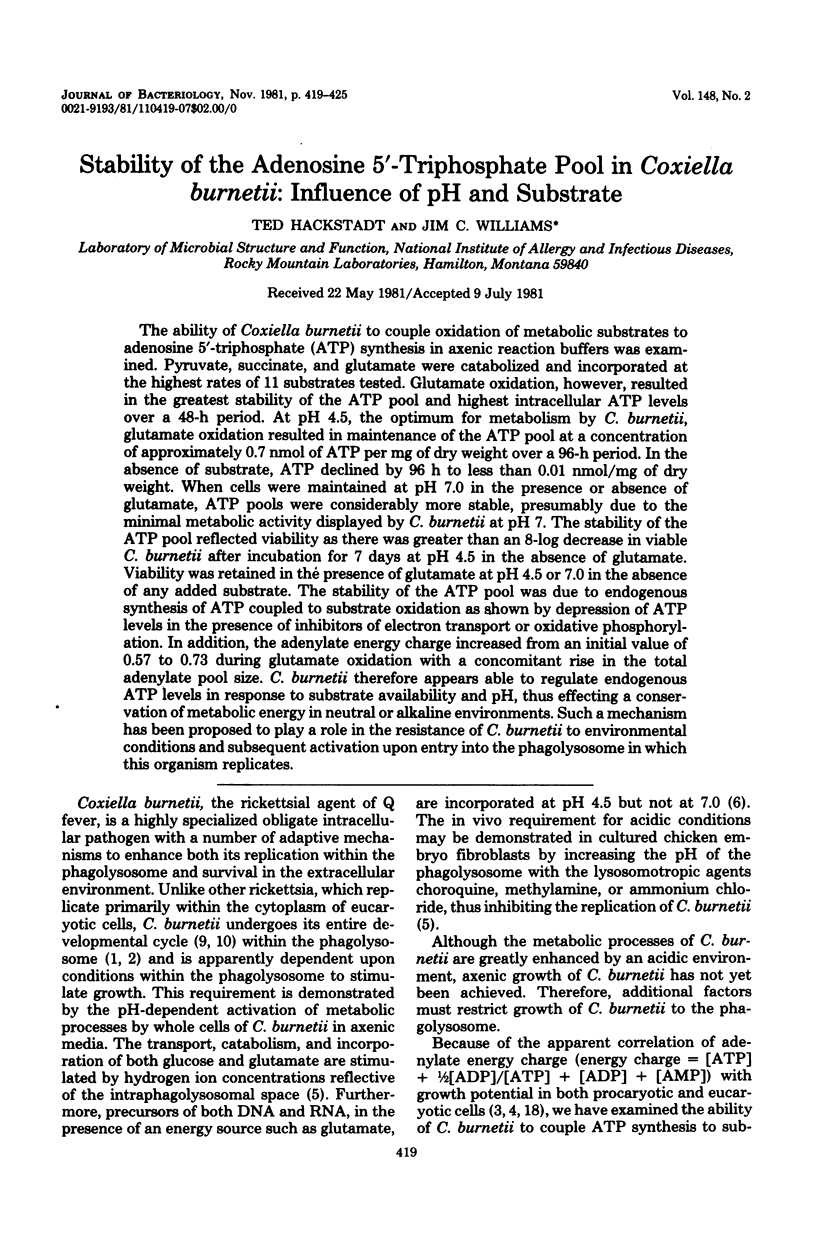
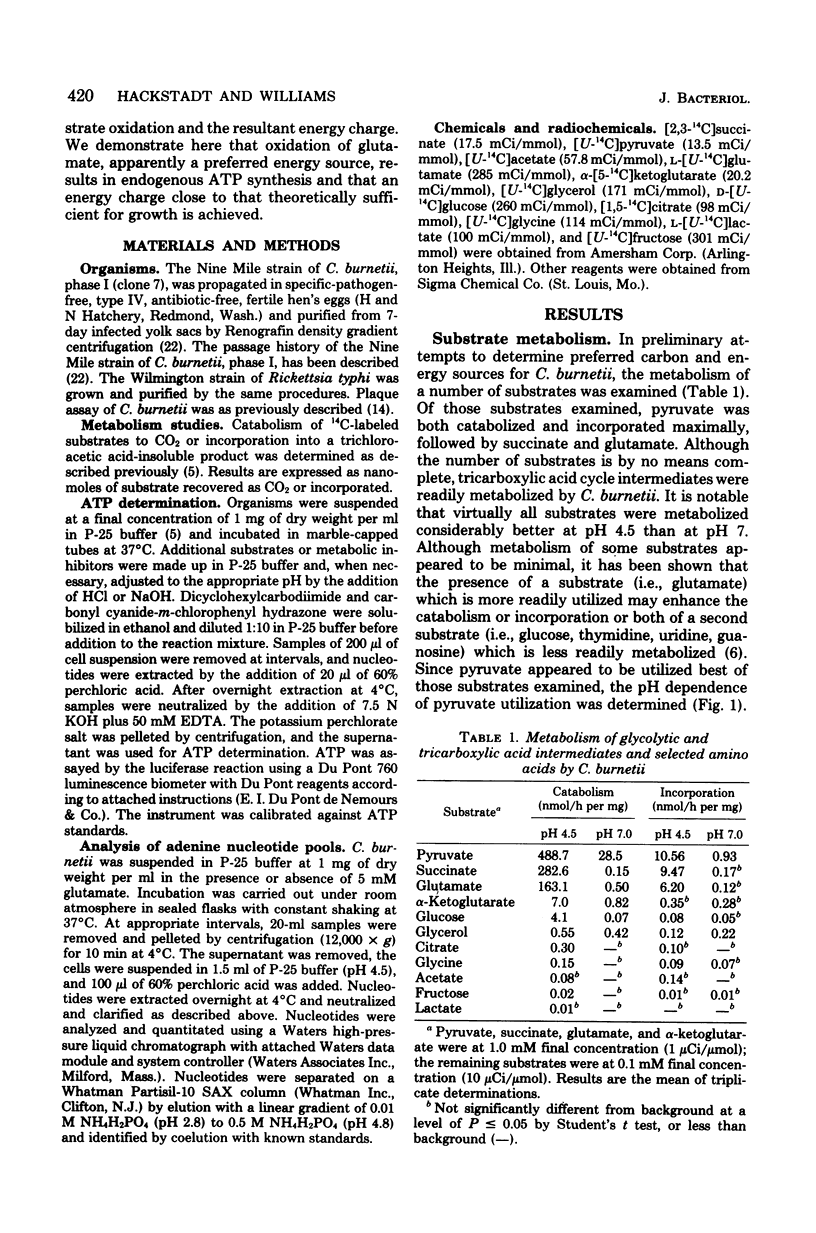
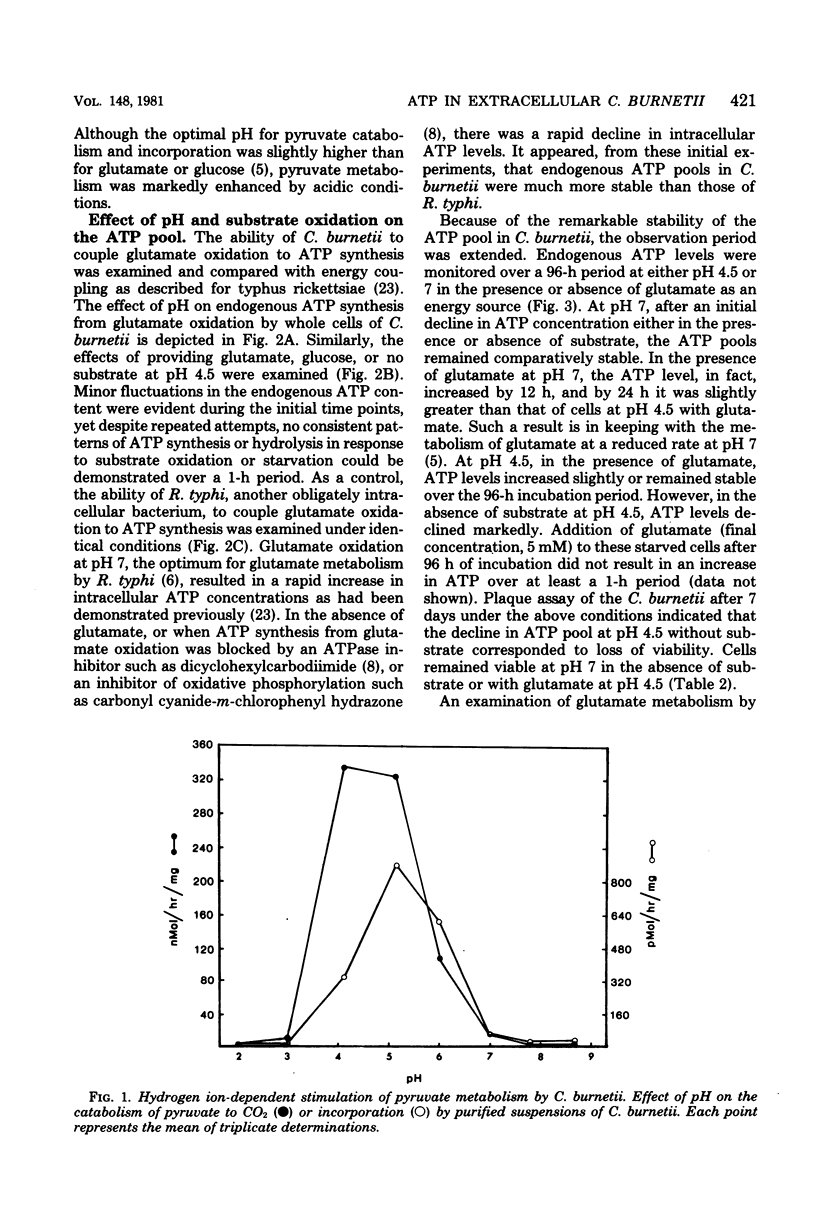
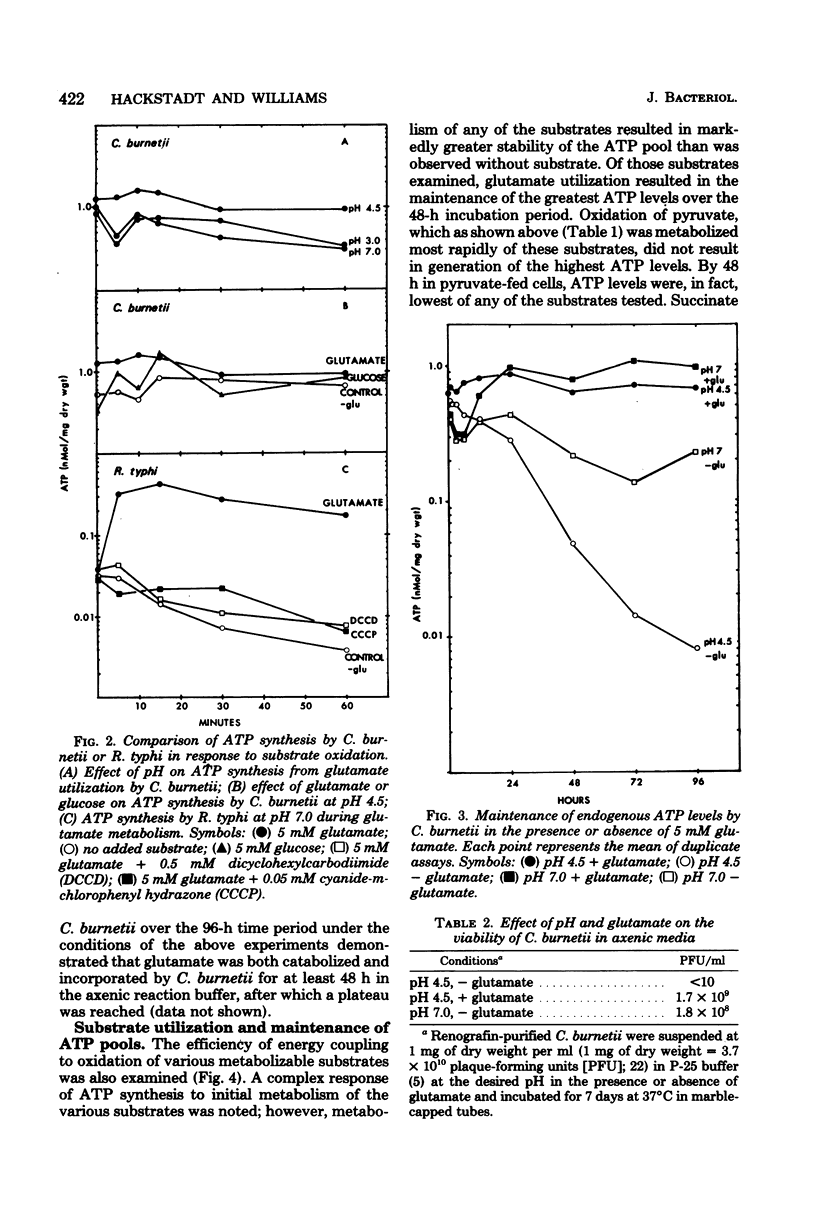
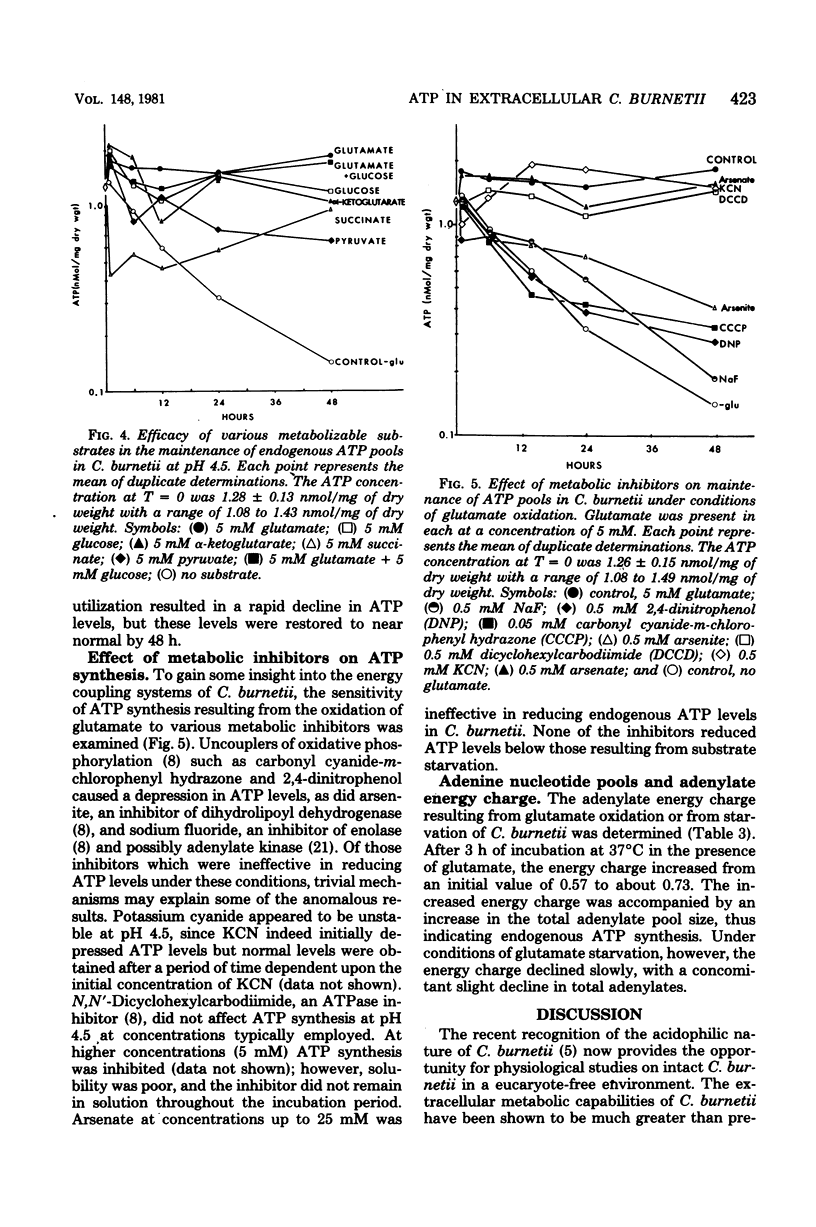
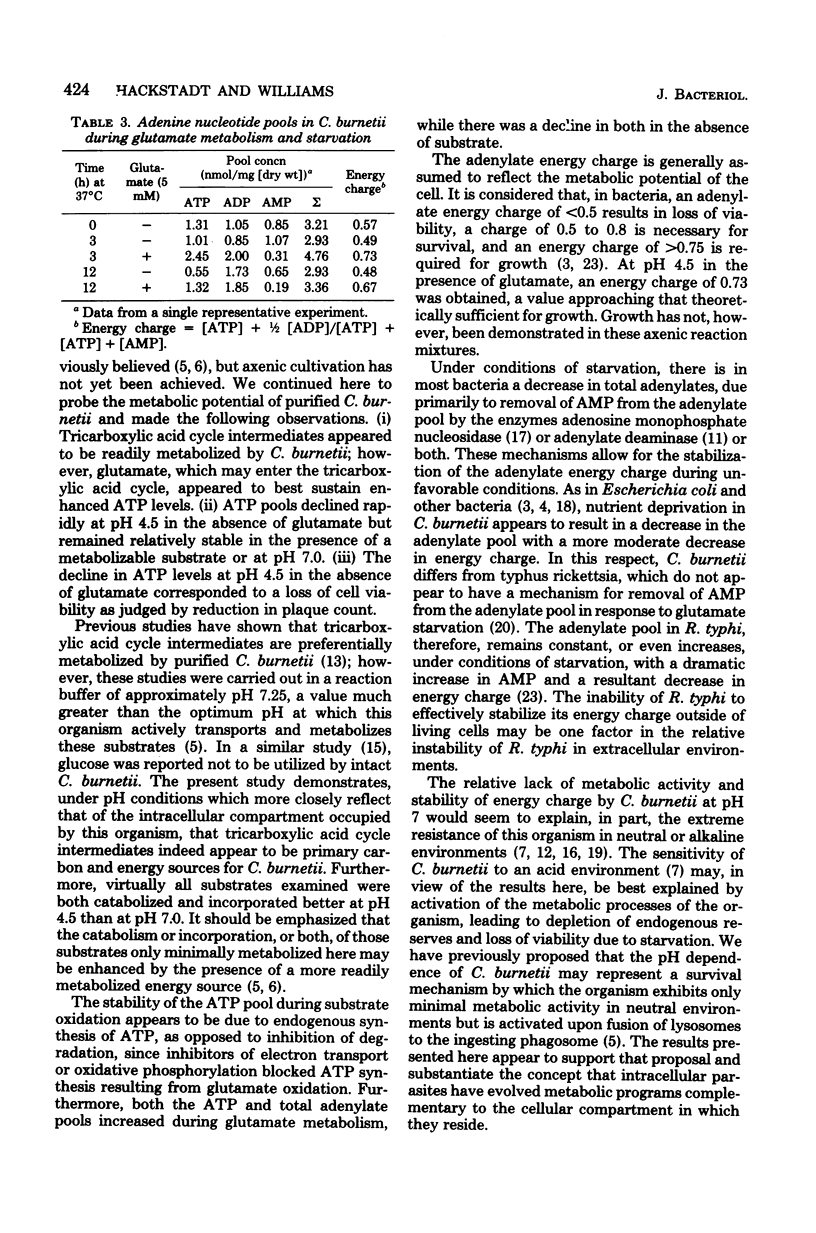
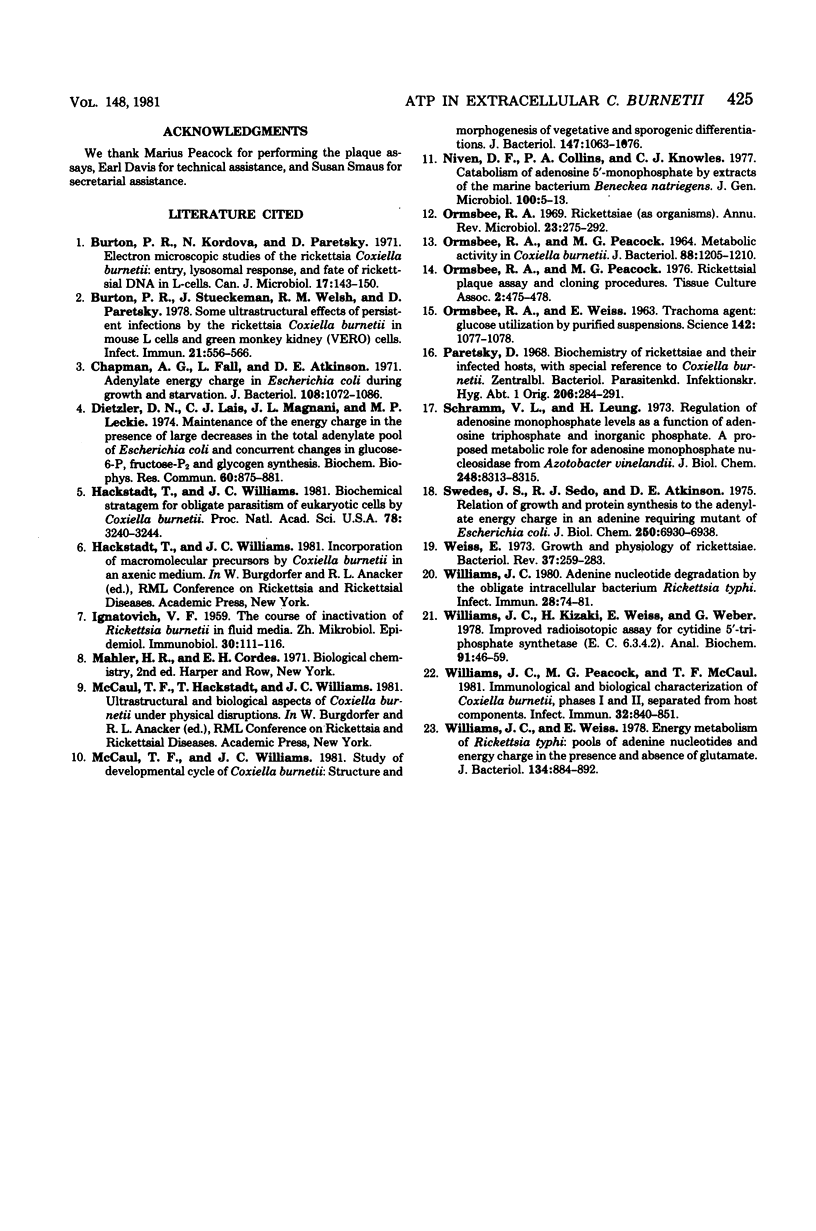
Selected References
These references are in PubMed. This may not be the complete list of references from this article.
- Burton P. R., Kordová N., Paretsky D. Electron microscopic studies of the rickettsia Coxiella burneti: entry, lysosomal response, and fate of rickettsial DNA in L-cells. Can J Microbiol. 1971 Feb;17(2):143–150. doi: 10.1139/m71-025. [DOI] [PubMed] [Google Scholar]
- Burton P. R., Stueckemann J., Welsh R. M., Paretsky D. Some ultrastructural effects of persistent infections by the rickettsia Coxiella burnetii in mouse L cells and green monkey kidney (Vero) cells. Infect Immun. 1978 Aug;21(2):556–566. doi: 10.1128/iai.21.2.556-566.1978. [DOI] [PMC free article] [PubMed] [Google Scholar]
- Chapman A. G., Fall L., Atkinson D. E. Adenylate energy charge in Escherichia coli during growth and starvation. J Bacteriol. 1971 Dec;108(3):1072–1086. doi: 10.1128/jb.108.3.1072-1086.1971. [DOI] [PMC free article] [PubMed] [Google Scholar]
- Dietzler D. N., Lais C. J., Magnani J. L., Leckie M. P. Maintenance of the energy charge in the presence of large decreases in the total adenylate pool of Escherichia coli and concurrent changes in glucose-6-p, fructose-p2 and glycogen synthesis. Biochem Biophys Res Commun. 1974 Oct 8;60(3):875–881. [PubMed] [Google Scholar]
- Hackstadt T., Williams J. C. Biochemical stratagem for obligate parasitism of eukaryotic cells by Coxiella burnetii. Proc Natl Acad Sci U S A. 1981 May;78(5):3240–3244. doi: 10.1073/pnas.78.5.3240. [DOI] [PMC free article] [PubMed] [Google Scholar]
- IGNATOVICH V. F. [Certain die-out rules of Rickettsia burneti in liquid media]. Zh Mikrobiol Epidemiol Immunobiol. 1959 Sep;30:111–116. [PubMed] [Google Scholar]
- McCaul T. F., Williams J. C. Developmental cycle of Coxiella burnetii: structure and morphogenesis of vegetative and sporogenic differentiations. J Bacteriol. 1981 Sep;147(3):1063–1076. doi: 10.1128/jb.147.3.1063-1076.1981. [DOI] [PMC free article] [PubMed] [Google Scholar]
- ORMSBEE R. A., PEACOCK M. G. METABOLIC ACTIVITY IN COXIELLA BURNETII. J Bacteriol. 1964 Nov;88:1205–1210. doi: 10.1128/jb.88.5.1205-1210.1964. [DOI] [PMC free article] [PubMed] [Google Scholar]
- ORMSBEE R. A., WEISS E. TRACHOMA AGENT: GLUCOSE UTILIZATION BY PURIFIED SUSPENSIONS. Science. 1963 Nov 22;142(3595):1077–1078. doi: 10.1126/science.142.3595.1077. [DOI] [PubMed] [Google Scholar]
- Ormsbee R. A. Rickettsiae (as organisms). Annu Rev Microbiol. 1969;23:275–292. doi: 10.1146/annurev.mi.23.100169.001423. [DOI] [PubMed] [Google Scholar]
- Schramm V. L., Leung H. Regulation of adenosine monophosphate levels as a function of adenosine triphosphate and inorganic phosphate. A proposed metabolic role for adenosine monophosphate nucleosidase from Azotobacter vinelandii. J Biol Chem. 1973 Dec 10;248(23):8313–8315. [PubMed] [Google Scholar]
- Swedes J. S., Sedo R. J., Atkinson D. E. Relation of growth and protein synthesis to the adenylate energy charge in an adenine-requiring mutant of Escherichia coli. J Biol Chem. 1975 Sep 10;250(17):6930–6938. [PubMed] [Google Scholar]
- Weiss E. Growth and physiology of rickettsiae. Bacteriol Rev. 1973 Sep;37(3):259–283. doi: 10.1128/br.37.3.259-283.1973. [DOI] [PMC free article] [PubMed] [Google Scholar]
- Williams J. C. Adenine nucleotide degradation by the obligate intracellular bacterium Rickettsia typhi. Infect Immun. 1980 Apr;28(1):74–81. doi: 10.1128/iai.28.1.74-81.1980. [DOI] [PMC free article] [PubMed] [Google Scholar]
- Williams J. C., Kizaki H., Weiss E., Weber G. Improved radioisotopic assay for cytidine 5'-triphosphate synthetase (EC 6.3.4.2). Anal Biochem. 1978 Nov;91(1):46–59. doi: 10.1016/0003-2697(78)90814-x. [DOI] [PubMed] [Google Scholar]
- Williams J. C., Peacock M. G., McCaul T. F. Immunological and biological characterization of Coxiella burnetii, phases I and II, separated from host components. Infect Immun. 1981 May;32(2):840–851. doi: 10.1128/iai.32.2.840-851.1981. [DOI] [PMC free article] [PubMed] [Google Scholar]
- Williams J. C., Weiss E. Energy metabolism of Rickettsia typhi: pools of adenine nucleotides and energy charge in the presence and absence of glutamate. J Bacteriol. 1978 Jun;134(3):884–892. doi: 10.1128/jb.134.3.884-892.1978. [DOI] [PMC free article] [PubMed] [Google Scholar]


